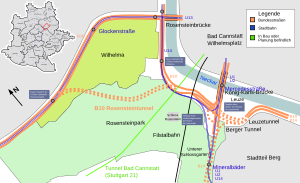Rosenstein tunnel (B 10)
| Rosenstein tunnel | ||
|---|---|---|
| use | Road tunnel | |
| traffic connection | B 10 | |
| place | Stuttgart | |
| length | 1300 m | |
| Number of tubes | 2 | |
| construction | ||
| Client | City of Stuttgart | |
| building-costs | € 329 million | |
| start of building | April 25, 2015 | |
| completion | End of 2024 | |
| business | ||
| release | End of 2024 | |
| map | ||
 Schematic view of the construction projects around the B10 Rosenstein tunnel
|
||
| location | ||
|
|
||
| Coordinates | ||
| North portal on Pragstrasse | 48 ° 48 '24 " N , 9 ° 11' 56" E | |
| South portal on Neckartalstrasse | 48 ° 48 '9 " N , 9 ° 12' 24" E | |
The Rosenstein Tunnel is a road tunnel under construction in Stuttgart . It is the largest infrastructure project in the city. The central structure is the B10 Rosenstein tunnel. With a total length of around 1,300 meters, this crosses under Rosenstein Park and parts of Wilhelma . The traffic is in two lanes directly between the Pragsattel and the junction on the Leuze. In addition, sections of the street in Pragstrasse and Neckartalstrasse will be replaced by green spaces, and access to the tram at Wilhelma will be made easier by relocating.
A third tube is being built in the Leuze area. It is to disentangle the traffic flows of the B10 and B14. A new short tunnel replaces the current B14 turnaround, so drivers can turn right into the city center. An additional ramp enables the B10 traffic from the direction of Pragsattel to have a direct connection over the König-Karls Bridge to Bad Cannstatt .
On May 20, 2010, the Stuttgart City Council approved the construction project, which cost 193.5 million euros. In October 2012, the Stuttgart municipal council finally approved the development plan for this project; on November 8, the local council voted by a majority in favor of building the tunnel. The regional press reported the first work in preparation for the tunnel construction in January 2014.
In the run-up to the construction work, the area along the course of the planned tunnel was searched for possible duds . Allied aerial photographs from World War II suggested this. This assumption has been confirmed by finds. Part of the park and Wilhelma were closed to the public on November 28, 2010 in order to defuse the duds found.
In the summer of 2014, the so-called Elefantensteg (over the B 10) and the part of the Leuzesteg that runs over the tram tracks were demolished for the project. In the area of this “elephant footbridge” (named after its painting, which indicated the nearby Wilhelma), work began on building the north portal of the tunnel. The official start of construction was on April 25, 2015. Two tunnel sponsors were present. The tunneling should run until spring 2016, after which the interior work is planned. Commissioning is scheduled for 2020. The federal and state governments are assuming a total of 112 million euros of the total costs, which are now estimated at more than 230 million euros. According to a press report from mid-May 2015, the expected costs, including the conversion of the Leuze node, have risen by around 40 to more than 270 million euros. The additional costs have to be financed by the state capital. The federal and state governments together continue to contribute 112 million euros. The administration put the costs at 329 million in the summer of 2019. As reasons, she also cited construction delays and legal disputes with the construction company, which resulted in a termination in 2017. The company denied the allegations and blamed the city for delays in construction due to planning changes. The dispute is now in court.
The breakthrough in the south tube took place on June 20, 2016, and in the north tube on July 11, 2016. The official breakthrough ceremony took place on September 16, 2016.
With the new construction of the B 10 road tunnel, the Berger Tunnel and the Schwanenplatz Tunnels will also be rebuilt.
Web links
Individual evidence
- ↑ Stuttgart City Council resolves the development plan of October 25, 2012, accessed on October 27, 2012
- ↑ City council votes for the construction of the Rosenstein tunnel Stuttgarter Zeitung, November 8, 2012.
- ↑ Trees fall for the Rosenstein tunnel. Retrieved February 10, 2014 .
- ↑ Duds found in Rosensteinpark ( page no longer available , search in web archives ) Info: The link was automatically marked as defective. Please check the link according to the instructions and then remove this notice. . State capital Stuttgart, Dept. Press and Communication, November 10, 2010.
- ↑ Elefantensteg in Bad Cannstatt (...) removed StZ (online) July 15, 2014.
- ↑ a b Erik Raidt: Things are moving forward in the Rosenstein tunnel . In: Stuttgarter Zeitung . April 27, 2015, p. 15 ( online ).
- ↑ Wolfgang Schulz-Braunschmidt: Cost explosion at the Rosenstein tunnel . In: Stuttgarter Zeitung . No. 114 , May 20, 2015, p. 19 ( online ).
- ↑ Thomas Braun: Rosenstein tunnel in Stuttgart: These are the reasons for the cost explosion. Stuttgarter Nachrichten, April 3, 2019, accessed on February 12, 2020 .
- ↑ Thomas Braun: Local politicians shine through their absence . In: Stuttgarter Zeitung . tape 72 , September 17, 2016, p. 22 (including title online ).
- ↑ The first cars are to roll in the Rosenstein Tunnel in 2015 ( Memento from July 10, 2009 in the Internet Archive ), Stuttgarter Zeitung from May 26, 2008




